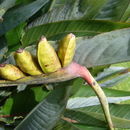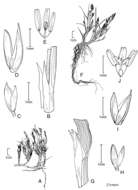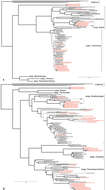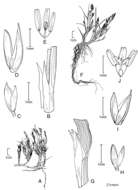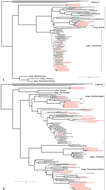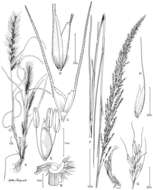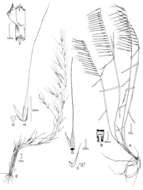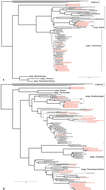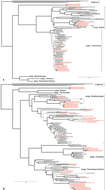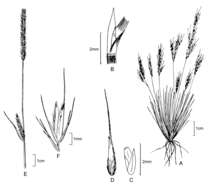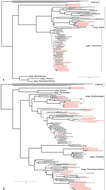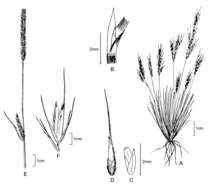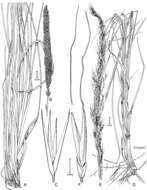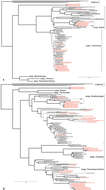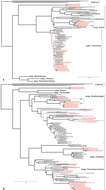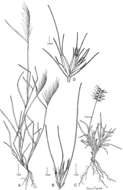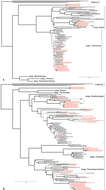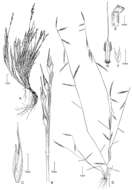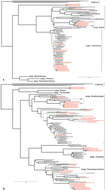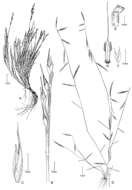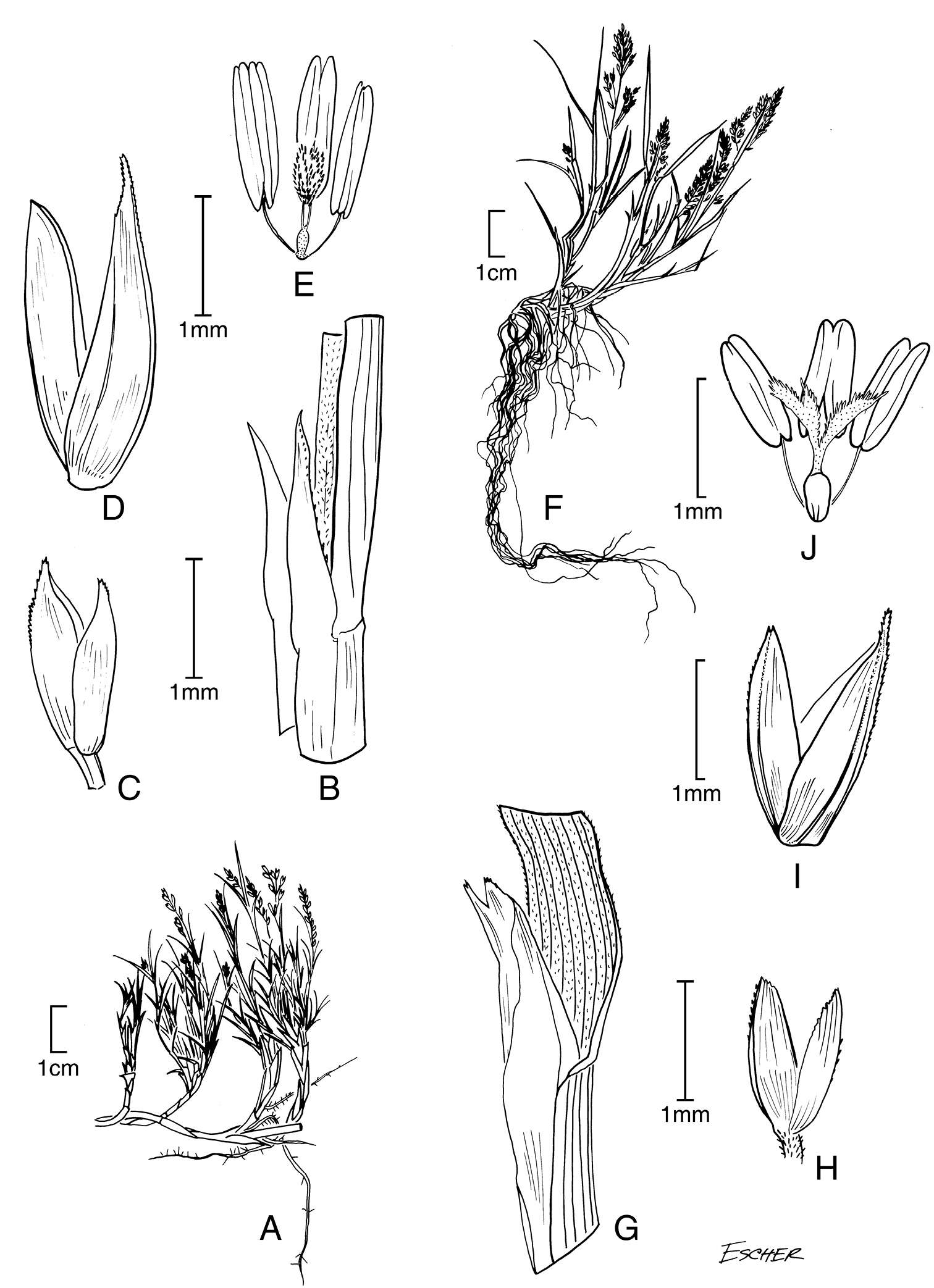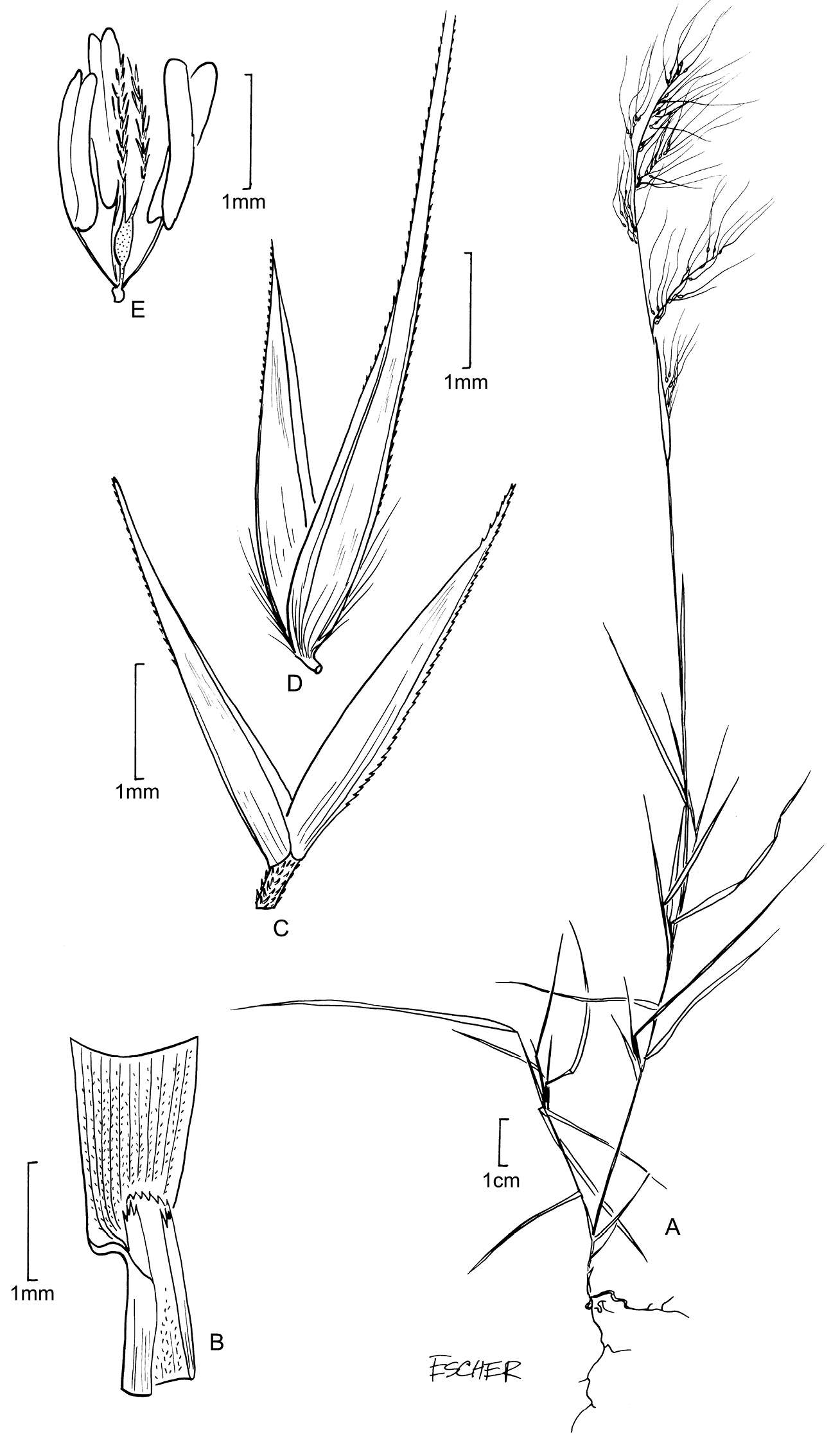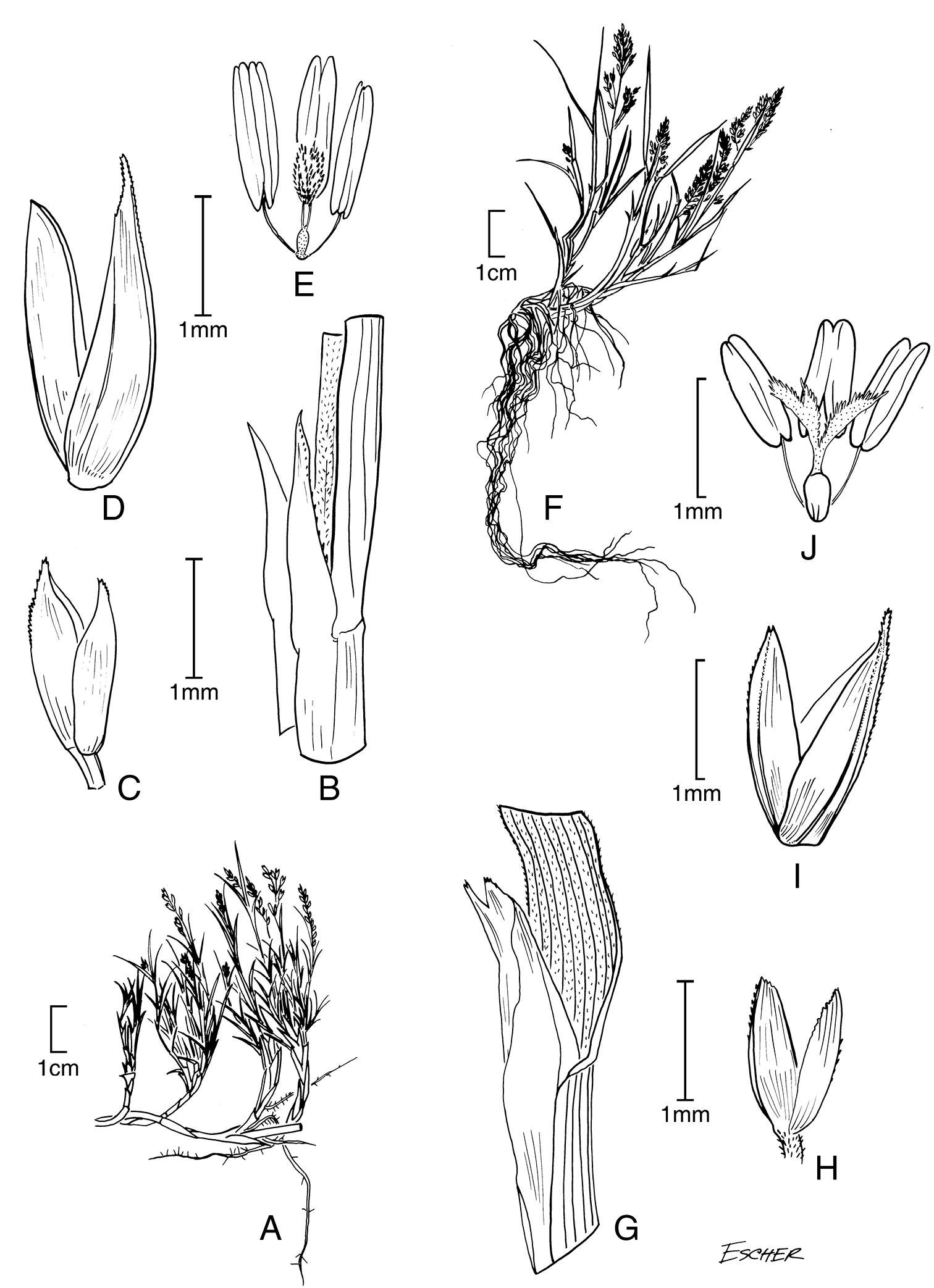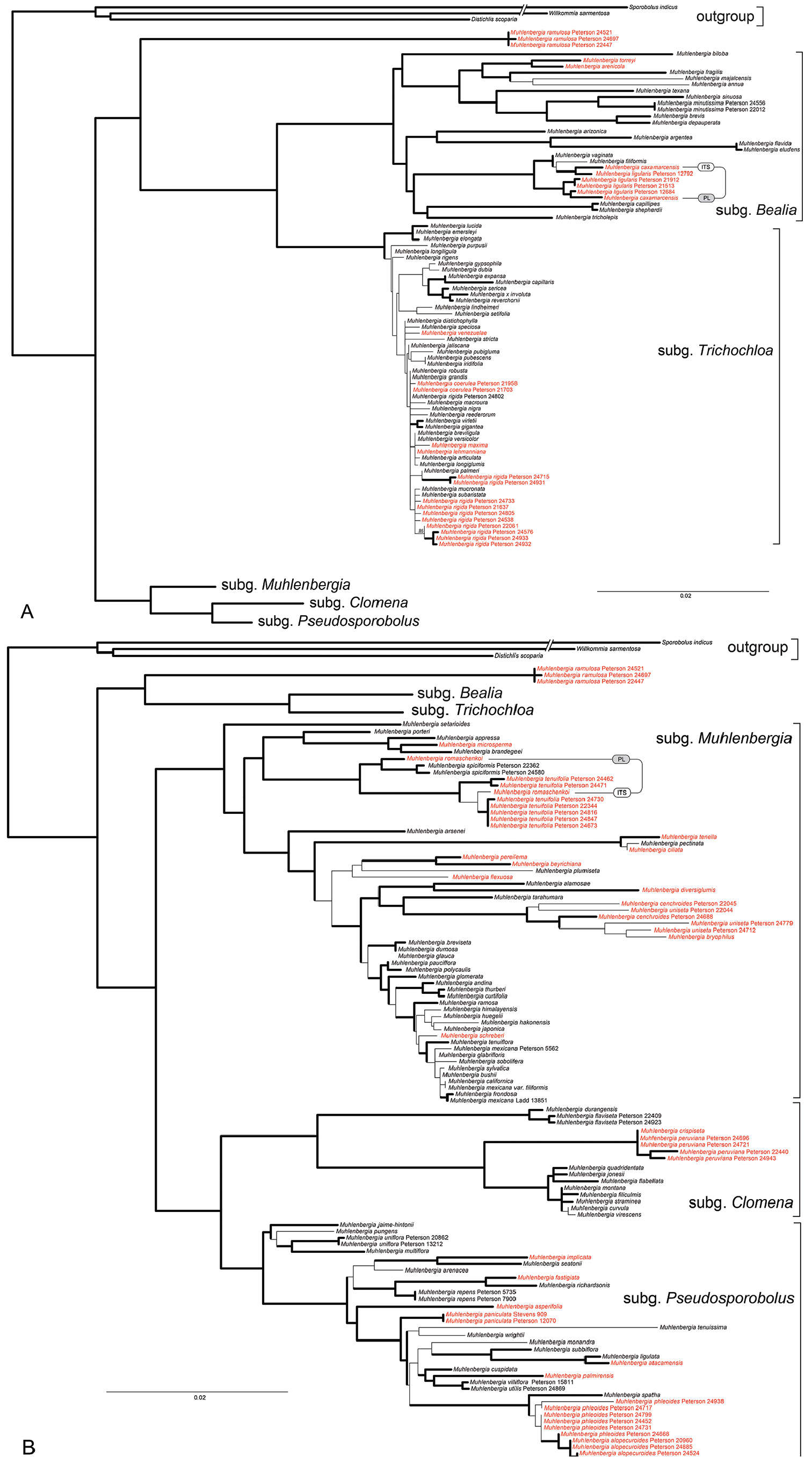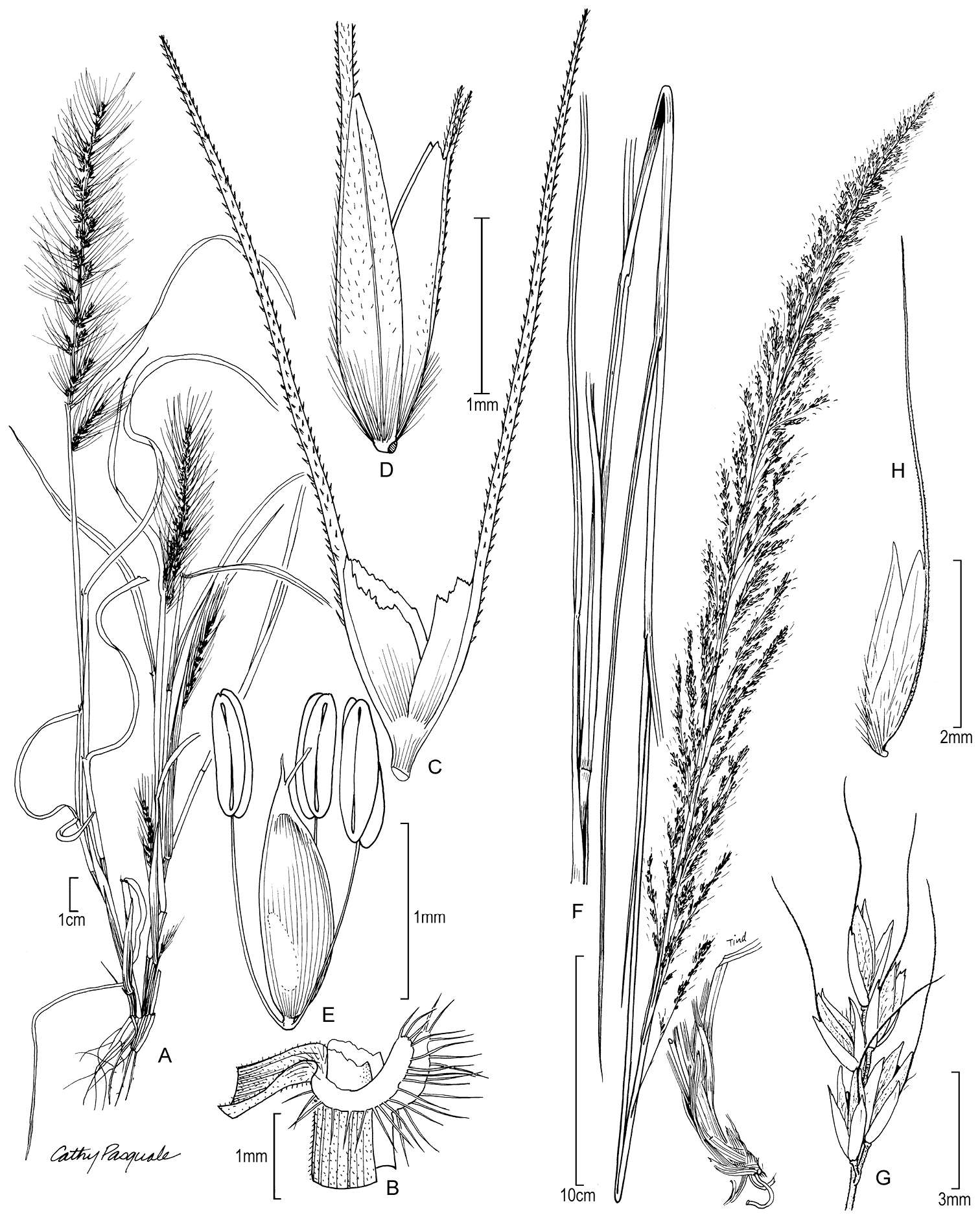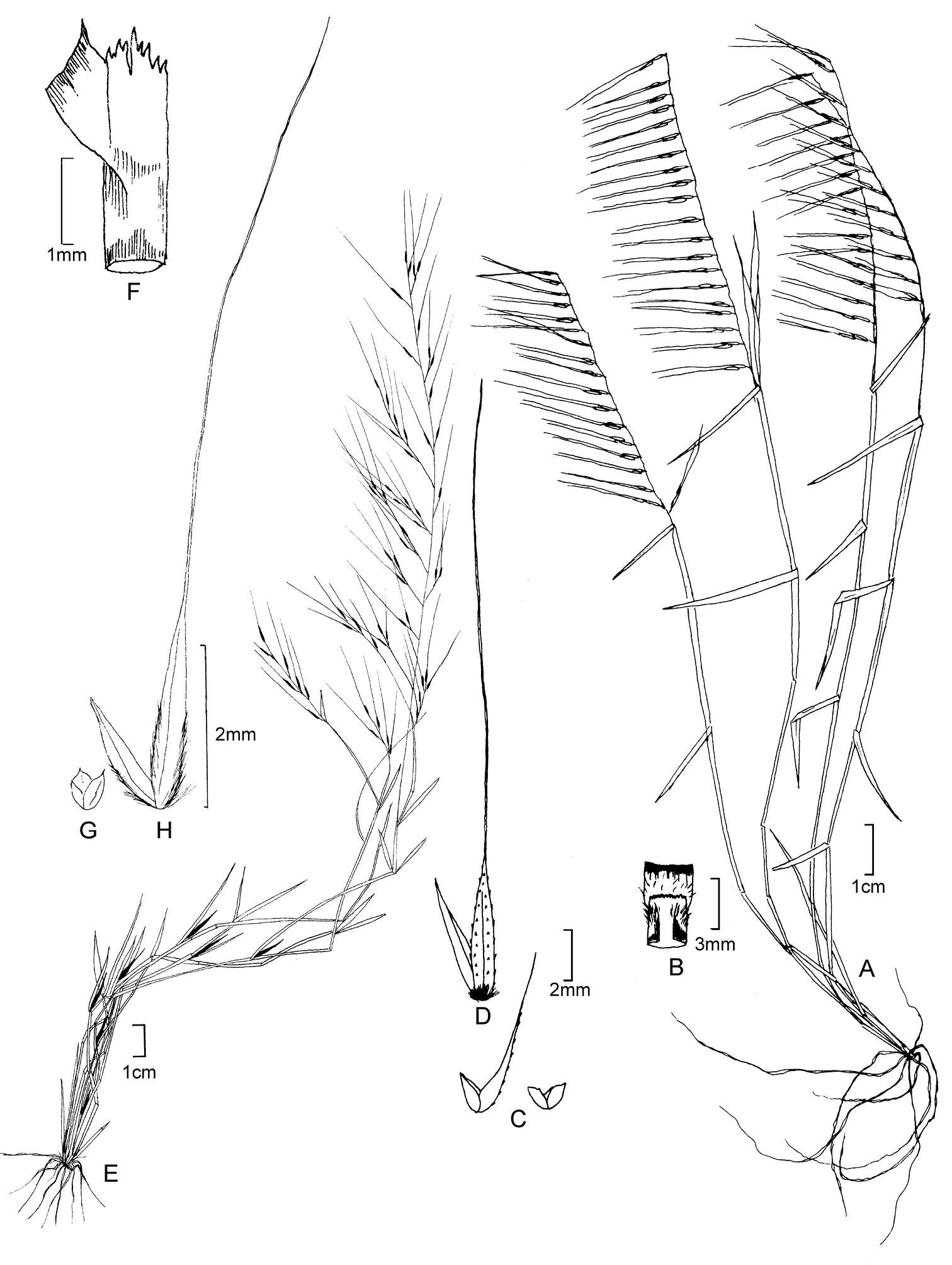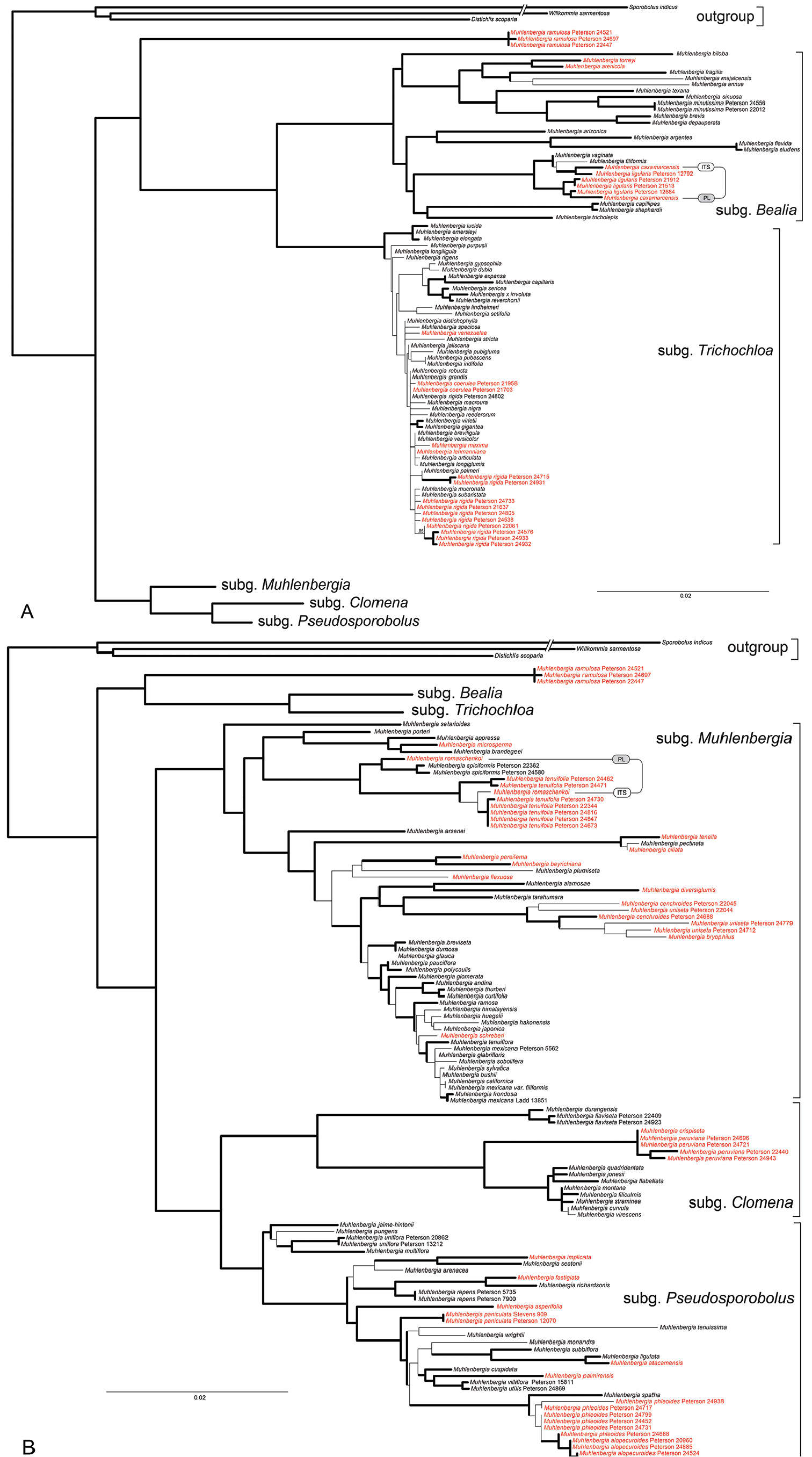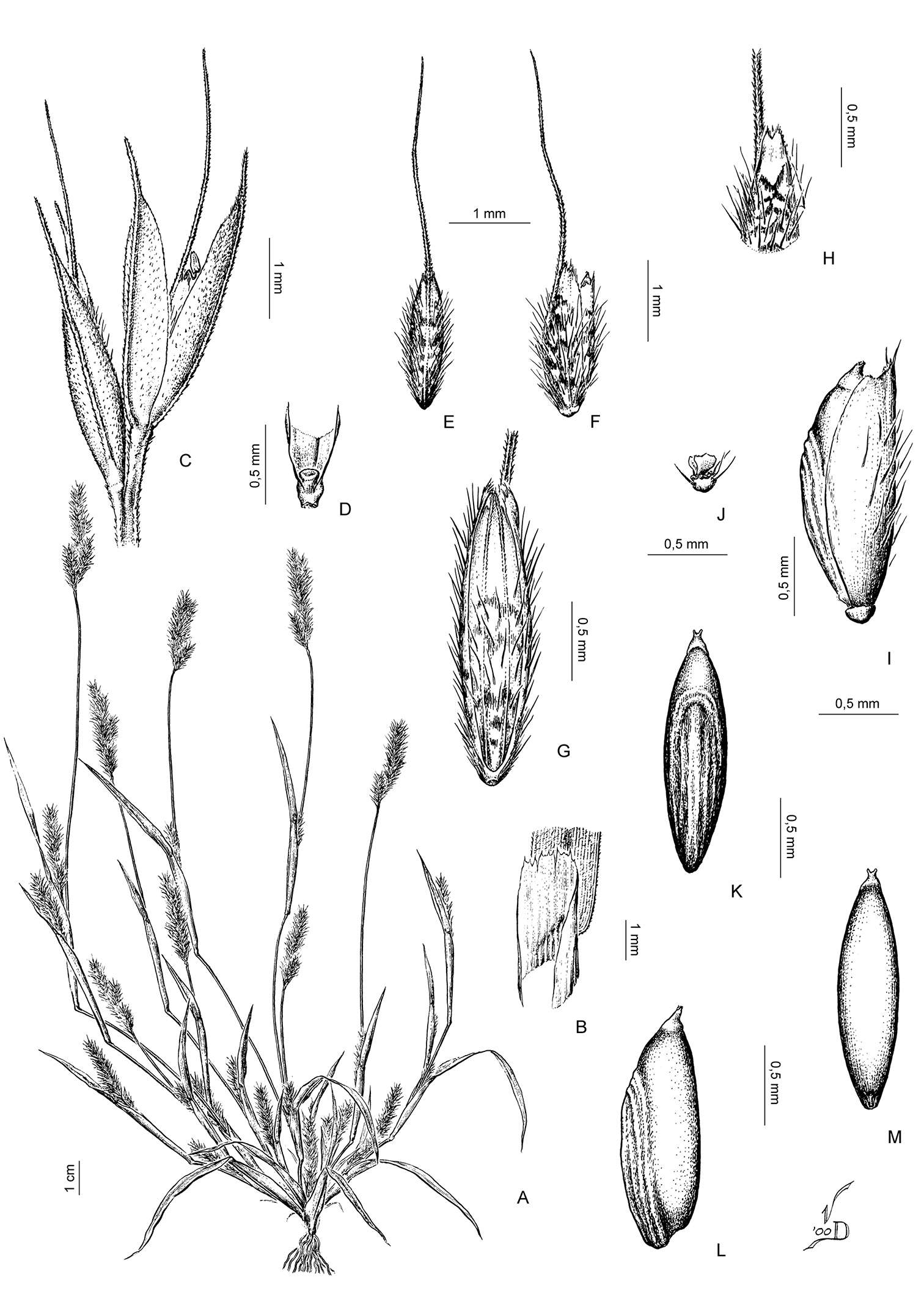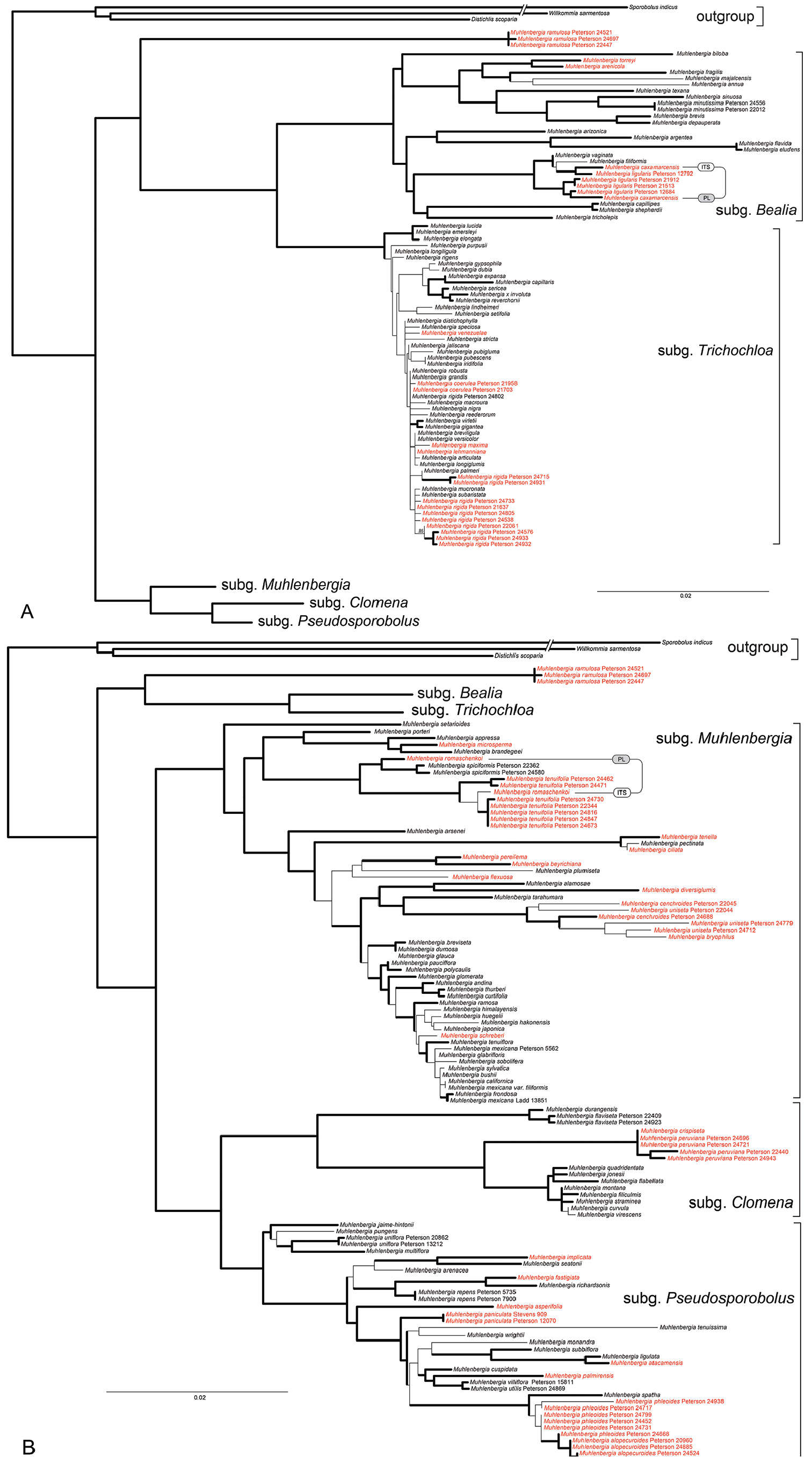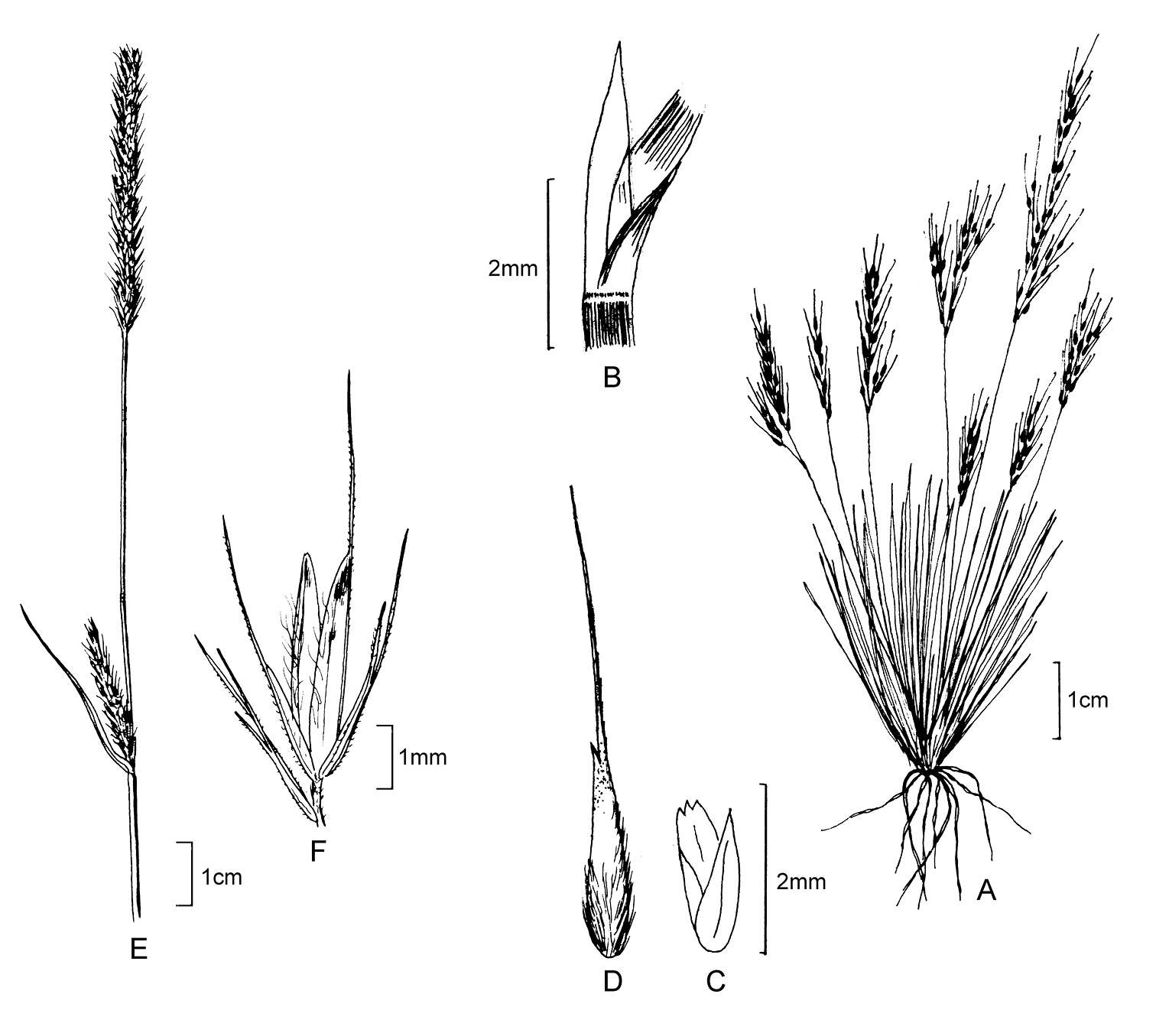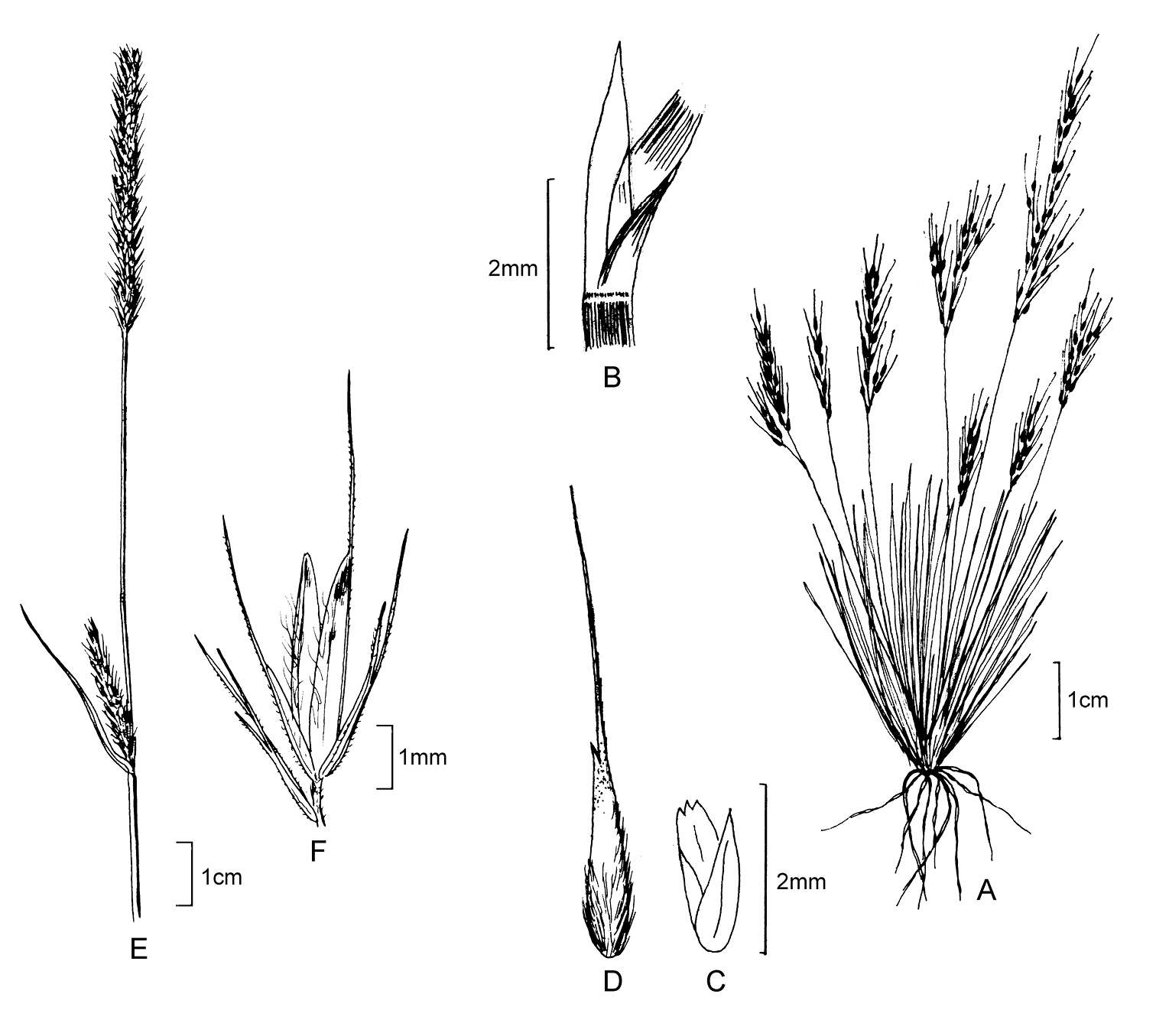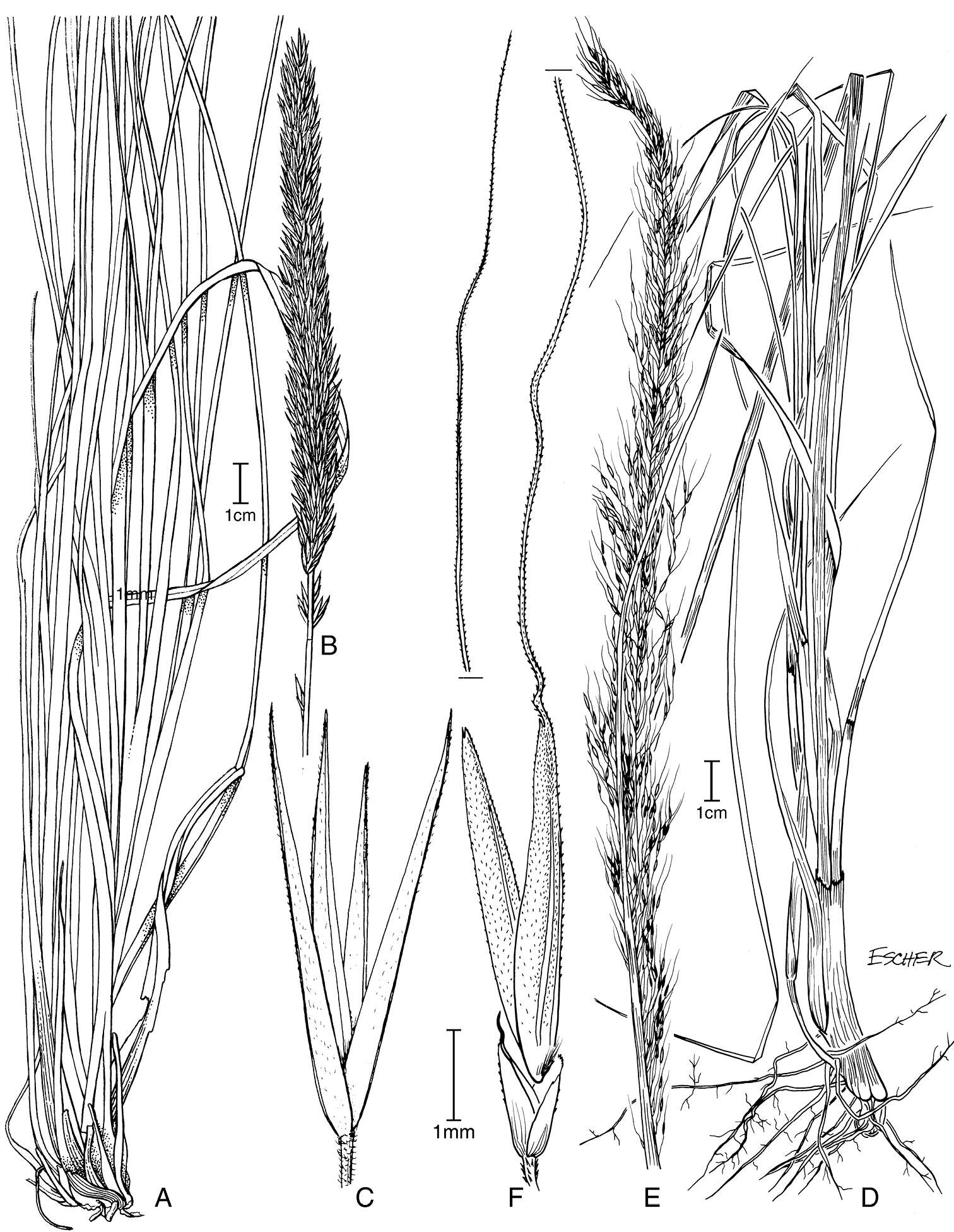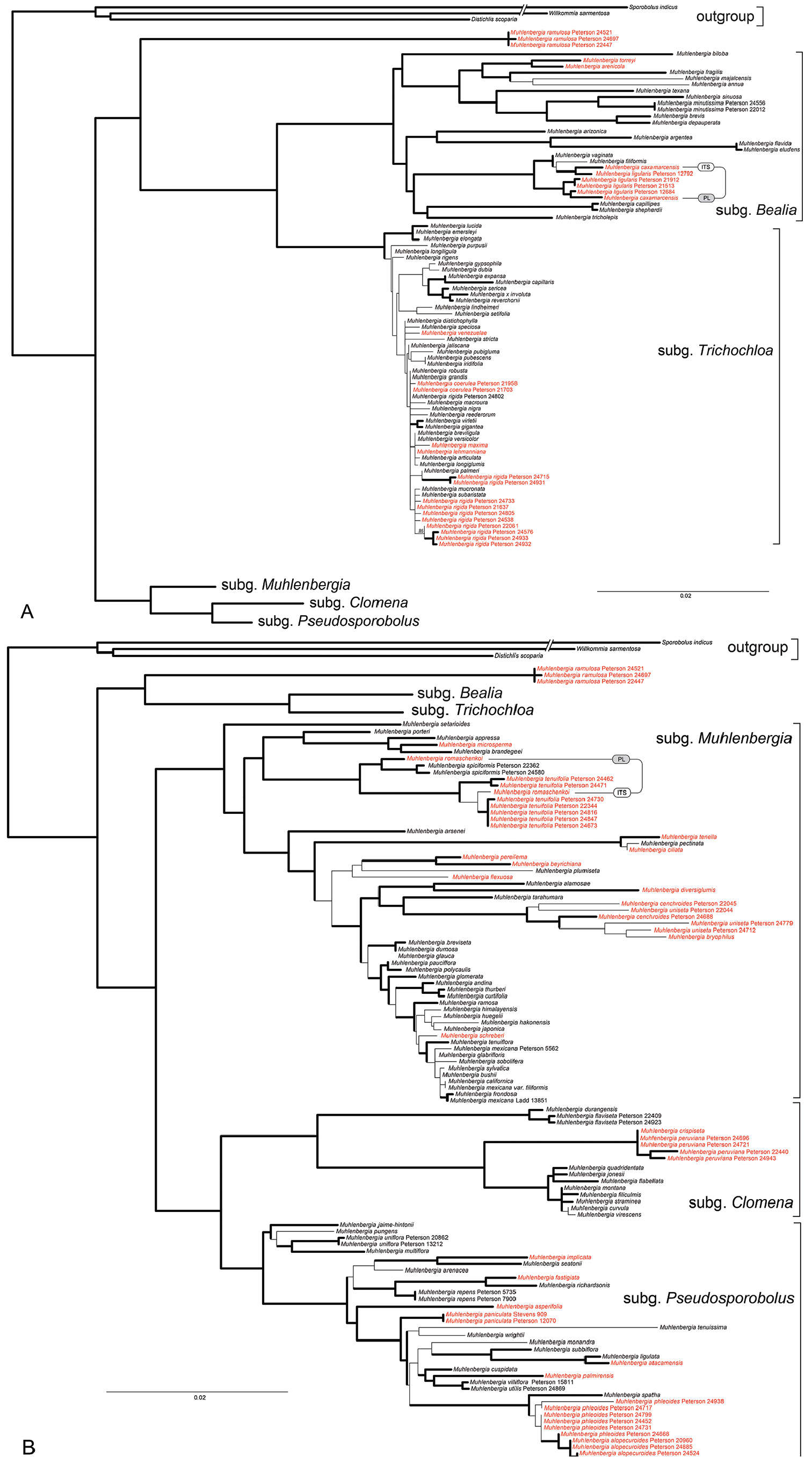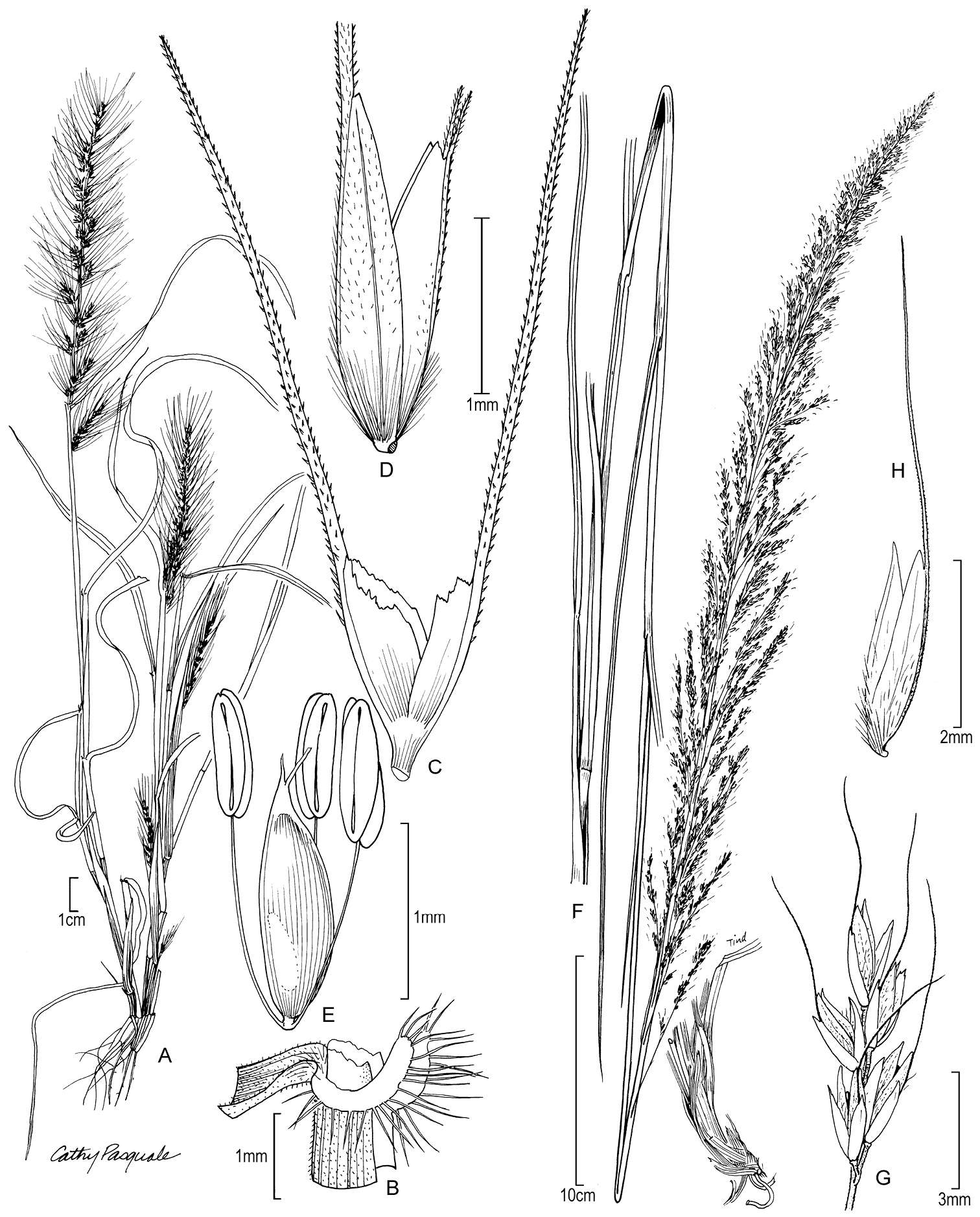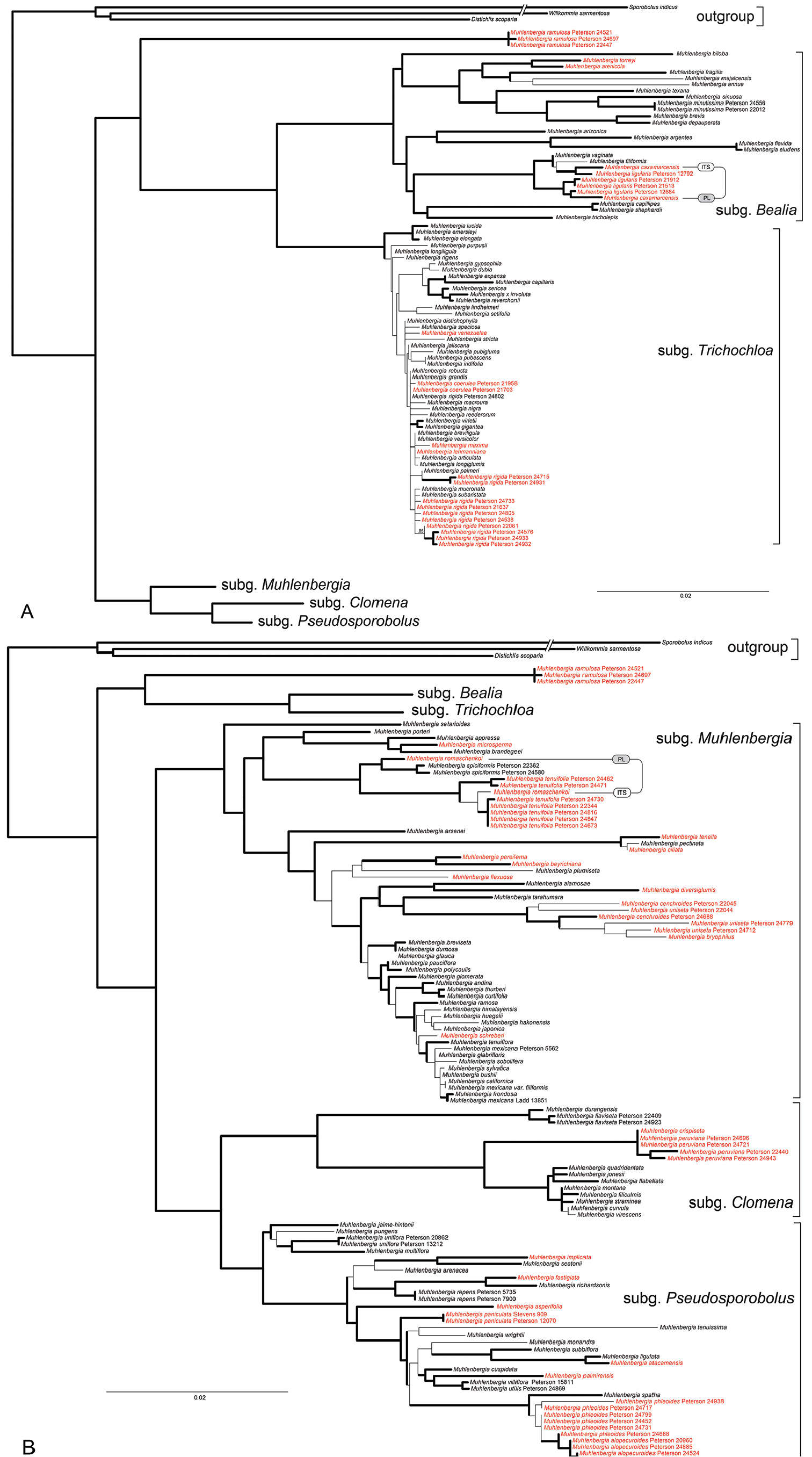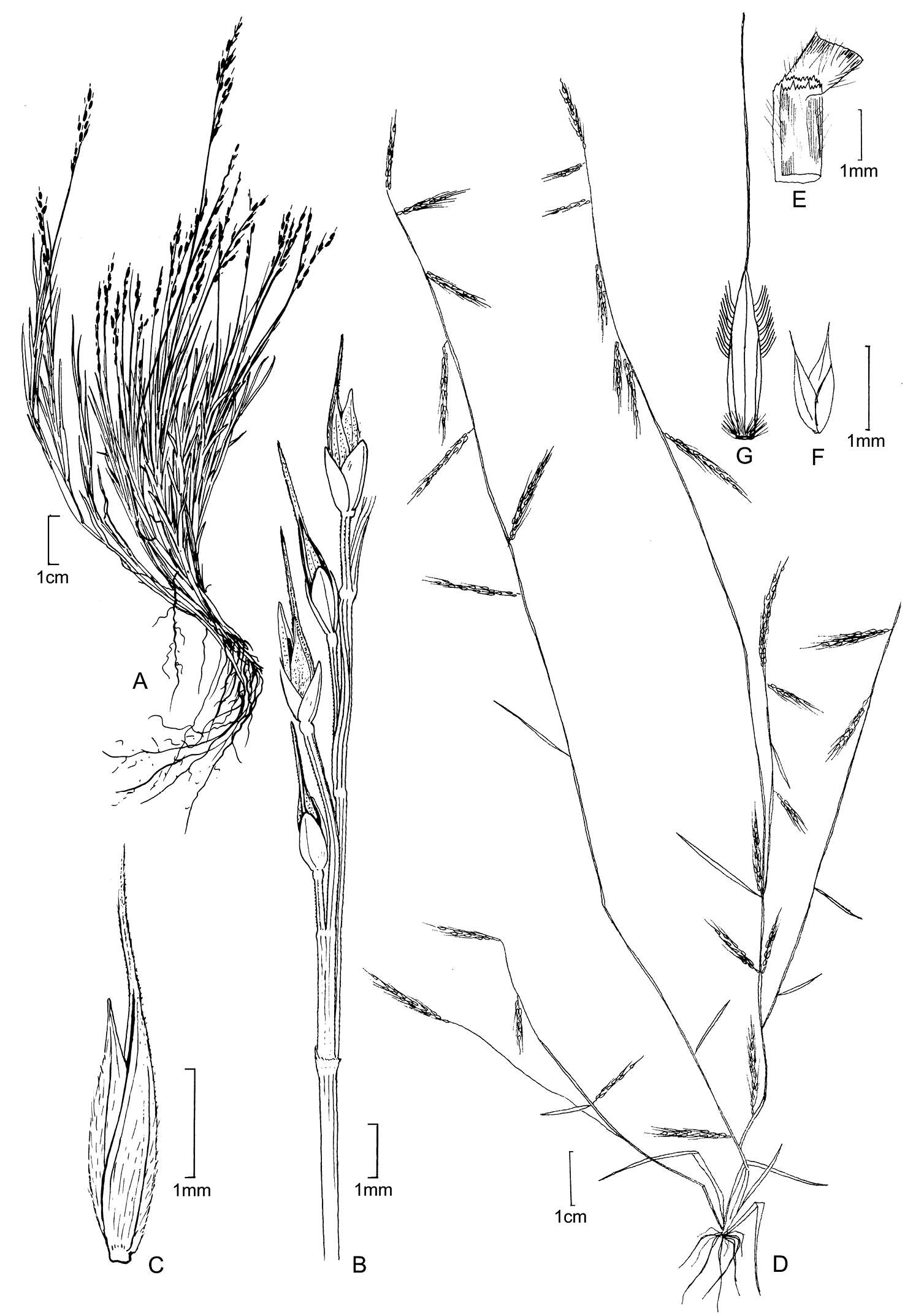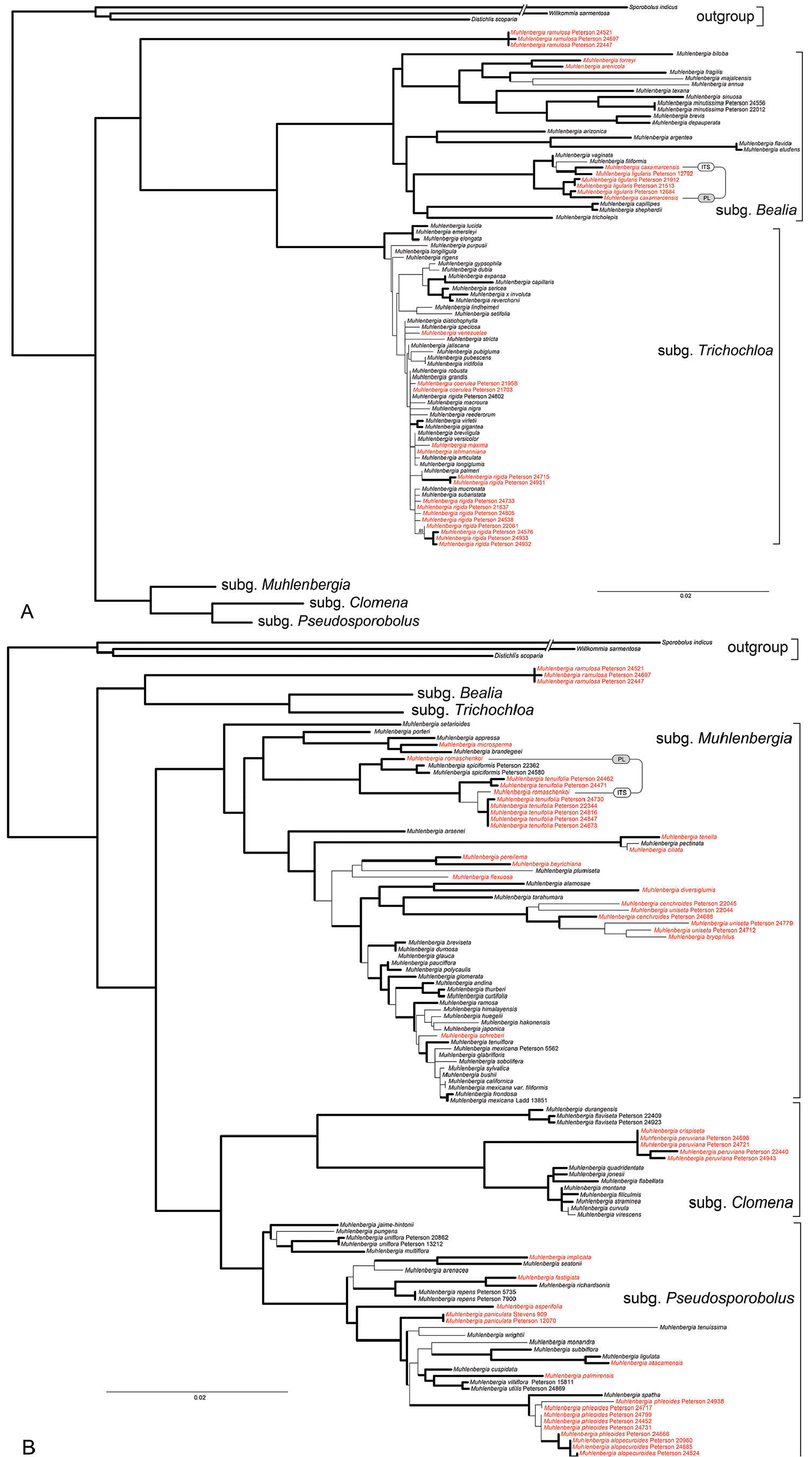-
Paul M. Peterson, Isidoro Sánchez Vega, Konstantin Romaschenko, Diego Giraldo-Cañas, Nancy F. Refulio Rodriguez
Phytokeys
Figure 8.
A−EMuhlenbergiafastigiata (J.Presl) Henrard A habit B ligule C glumes D floret E stamens and pistil F−JMuhlenbergialigularais (Hack.) Hitchc F habit G ligule H glumes I floret J stamens and pistil. Drawings from Giraldo-Cañas and Peterson (2009), Peterson and Giraldo-Cañas (2011)A−E drawn from P.M. Peterson, S. Lægaard, R.J. Soreng & C.R. Annable 12709 (US) F−J drawn from P.M. Peterson, S. Lægaard, R.J. Soreng & C.R. Annable 12684 (US).
-
Paul M. Peterson, Isidoro Sánchez Vega, Konstantin Romaschenko, Diego Giraldo-Cañas, Nancy F. Refulio Rodriguez
Phytokeys
Figure 1.
A, B Maximum-likelihood tree inferred from combined plastid (ndhA intron, rps16-trnK, rps16 intron, rps3, and rpl32-trnL) and ITS sequences. Thick branches indicate posterior probabilities of 0.95−1; species in red occur in South America; scale bar = 2%.
-
Paul M. Peterson, Isidoro Sánchez Vega, Konstantin Romaschenko, Diego Giraldo-Cañas, Nancy F. Refulio Rodriguez
Phytokeys
Figure 9.
A−EMuhlenbergiaflexuosa Hitchc. A habit B ligule C glumes D floret E stamens and pistil. Drawn from H. Teppner 79-293 (US).
-
Paul M. Peterson, Isidoro Sánchez Vega, Konstantin Romaschenko, Diego Giraldo-Cañas, Nancy F. Refulio Rodriguez
Phytokeys
Figure 1.
A, B Maximum-likelihood tree inferred from combined plastid (ndhA intron, rps16-trnK, rps16 intron, rps3, and rpl32-trnL) and ITS sequences. Thick branches indicate posterior probabilities of 0.95−1; species in red occur in South America; scale bar = 2%.
-
Paul M. Peterson, Isidoro Sánchez Vega, Konstantin Romaschenko, Diego Giraldo-Cañas, Nancy F. Refulio Rodriguez
Phytokeys
Figure 8.
A−EMuhlenbergiafastigiata (J.Presl) Henrard A habit B ligule C glumes D floret E stamens and pistil F−JMuhlenbergialigularais (Hack.) Hitchc F habit G ligule H glumes I floret J stamens and pistil. Drawings from Giraldo-Cañas and Peterson (2009), Peterson and Giraldo-Cañas (2011)A−E drawn from P.M. Peterson, S. Lægaard, R.J. Soreng & C.R. Annable 12709 (US) F−J drawn from P.M. Peterson, S. Lægaard, R.J. Soreng & C.R. Annable 12684 (US).
-
Paul M. Peterson, Isidoro Sánchez Vega, Konstantin Romaschenko, Diego Giraldo-Cañas, Nancy F. Refulio Rodriguez
Phytokeys
Figure 1.
A, B Maximum-likelihood tree inferred from combined plastid (ndhA intron, rps16-trnK, rps16 intron, rps3, and rpl32-trnL) and ITS sequences. Thick branches indicate posterior probabilities of 0.95−1; species in red occur in South America; scale bar = 2%.
-
Paul M. Peterson, Isidoro Sánchez Vega, Konstantin Romaschenko, Diego Giraldo-Cañas, Nancy F. Refulio Rodriguez
Phytokeys
Figure 2.
A−EMuhlenbergiabeyrichiana Kunth A habit B ligule with auricles C glumes D floret E stamens and pistil F−HMuhlenbergiamaxima Lægaard & Sánchez Vega F habit G end of panicle branch H floret. A−E drawn from A.S. Hitchcock 20635 (US) F−H drawings from Lægaard & Sánchez Vega (1990) drawn from the holotype collection Sánchez Vega & Ruíz Vigo 3561.
-
Paul M. Peterson, Isidoro Sánchez Vega, Konstantin Romaschenko, Diego Giraldo-Cañas, Nancy F. Refulio Rodriguez
Phytokeys
Figure 7.
A−DMuhlenbergiadiversiglumis Trin A habit B ligule C glumes D floret E−HMuhlenbergiamicrosperma (DC.) Kunth E habit F ligule G glumes H lemma. Drawings from Peterson and Annable (1991)A−D drawn from P.M. Peterson & C.R. Annable 4158 (WS) F−H drawn from P.M. Peterson & C.R. Annable 4185 (WS).
-
Paul M. Peterson, Isidoro Sánchez Vega, Konstantin Romaschenko, Diego Giraldo-Cañas, Nancy F. Refulio Rodriguez
Phytokeys
Figure 1.
A, B Maximum-likelihood tree inferred from combined plastid (ndhA intron, rps16-trnK, rps16 intron, rps3, and rpl32-trnL) and ITS sequences. Thick branches indicate posterior probabilities of 0.95−1; species in red occur in South America; scale bar = 2%.
-
Paul M. Peterson, Isidoro Sánchez Vega, Konstantin Romaschenko, Diego Giraldo-Cañas, Nancy F. Refulio Rodriguez
Phytokeys
Figure 10.
A−MMuhlenbergiamonandra Alegría & Rúgolo A habit B ligule C two spikelets D glume base and rachilla E lemma, dorsal view F floret, side view G floret, ventral view H apex of lemma with two small teeth I palea and caryopsis, lateral view J lodícules K caryopsis, dorsal view L caryopsis, lateral view M caryopsis, ventral view. Drawings from the holotype collection Granda Paucar & Alegría Olivera 2230.
-
Paul M. Peterson, Isidoro Sánchez Vega, Konstantin Romaschenko, Diego Giraldo-Cañas, Nancy F. Refulio Rodriguez
Phytokeys
Figure 1.
A, B Maximum-likelihood tree inferred from combined plastid (ndhA intron, rps16-trnK, rps16 intron, rps3, and rpl32-trnL) and ITS sequences. Thick branches indicate posterior probabilities of 0.95−1; species in red occur in South America; scale bar = 2%.
-
Paul M. Peterson, Isidoro Sánchez Vega, Konstantin Romaschenko, Diego Giraldo-Cañas, Nancy F. Refulio Rodriguez
Phytokeys
Figure 11.
A−DMuhlenbergiaperuviana (P. Beauv.) Steud A habit B ligule C glumes D floret E, FMuhlenbergiaphalaroides (Kunth) P.M. Peterson E panicle
F spikelet. Drawings A−D from Peterson and Annable (1991) drawn from P.M. Peterson & C.R. Annable 4739 (WS) E, F from Giraldo-Cañas and Peterson (2009) drawn from S. Lægaard 71419 (AAU).
-
Paul M. Peterson, Isidoro Sánchez Vega, Konstantin Romaschenko, Diego Giraldo-Cañas, Nancy F. Refulio Rodriguez
Phytokeys
Figure 1.
A, B Maximum-likelihood tree inferred from combined plastid (ndhA intron, rps16-trnK, rps16 intron, rps3, and rpl32-trnL) and ITS sequences. Thick branches indicate posterior probabilities of 0.95−1; species in red occur in South America; scale bar = 2%.
-
Paul M. Peterson, Isidoro Sánchez Vega, Konstantin Romaschenko, Diego Giraldo-Cañas, Nancy F. Refulio Rodriguez
Phytokeys
Figure 11.
A−DMuhlenbergiaperuviana (P. Beauv.) Steud A habit B ligule C glumes D floret E, FMuhlenbergiaphalaroides (Kunth) P.M. Peterson E panicle
F spikelet. Drawings A−D from Peterson and Annable (1991) drawn from P.M. Peterson & C.R. Annable 4739 (WS) E, F from Giraldo-Cañas and Peterson (2009) drawn from S. Lægaard 71419 (AAU).
-
Paul M. Peterson, Isidoro Sánchez Vega, Konstantin Romaschenko, Diego Giraldo-Cañas, Nancy F. Refulio Rodriguez
Phytokeys
Figure 6.
A−CMuhlenbergiacoerulea (Griseb.) Mez A habit B panicle C spikelet D−FMuhlenbergiarigida (Kunth) Kunth D habit E panicle F spikelet. Drawings from Giraldo-Cañas and Peterson (2009), Peterson and Giraldo-Cañas (2011). A−C drawn from S.G. Beck 7700 (LPB) D drawn from P.M. Peterson 9659 (US) E, F drawn from P.M. Peterson, C.R. Annable & J. Valdés-Reyna 10876 (US).
-
Paul M. Peterson, Isidoro Sánchez Vega, Konstantin Romaschenko, Diego Giraldo-Cañas, Nancy F. Refulio Rodriguez
Phytokeys
Figure 1.
A, B Maximum-likelihood tree inferred from combined plastid (ndhA intron, rps16-trnK, rps16 intron, rps3, and rpl32-trnL) and ITS sequences. Thick branches indicate posterior probabilities of 0.95−1; species in red occur in South America; scale bar = 2%.
-
Paul M. Peterson, Isidoro Sánchez Vega, Konstantin Romaschenko, Diego Giraldo-Cañas, Nancy F. Refulio Rodriguez
Phytokeys
Figure 2.
A−EMuhlenbergiabeyrichiana Kunth A habit B ligule with auricles C glumes D floret E stamens and pistil F−HMuhlenbergiamaxima Lægaard & Sánchez Vega F habit G end of panicle branch H floret. A−E drawn from A.S. Hitchcock 20635 (US) F−H drawings from Lægaard & Sánchez Vega (1990) drawn from the holotype collection Sánchez Vega & Ruíz Vigo 3561.
-
Paul M. Peterson, Isidoro Sánchez Vega, Konstantin Romaschenko, Diego Giraldo-Cañas, Nancy F. Refulio Rodriguez
Phytokeys
Figure 1.
A, B Maximum-likelihood tree inferred from combined plastid (ndhA intron, rps16-trnK, rps16 intron, rps3, and rpl32-trnL) and ITS sequences. Thick branches indicate posterior probabilities of 0.95−1; species in red occur in South America; scale bar = 2%.
-
Paul M. Peterson, Isidoro Sánchez Vega, Konstantin Romaschenko, Diego Giraldo-Cañas, Nancy F. Refulio Rodriguez
Phytokeys
Figure 3.
A, BMuhlenbergiabryophilus (Döll) P. M. Peterson A habit B spikelet C, DMuhlenbergiacenchroides (Humb. & Bonpl. ex Willd.) P. M. Peterson C habit D spikelet. Drawings from Giraldo-Cañas and Peterson (2009)A, B drawn from S.G. Beck 818 (LPB) C, D drawn from S.G. Beck 7464 (LPB).
-
Paul M. Peterson, Isidoro Sánchez Vega, Konstantin Romaschenko, Diego Giraldo-Cañas, Nancy F. Refulio Rodriguez
Phytokeys
Figure 1.
A, B Maximum-likelihood tree inferred from combined plastid (ndhA intron, rps16-trnK, rps16 intron, rps3, and rpl32-trnL) and ITS sequences. Thick branches indicate posterior probabilities of 0.95−1; species in red occur in South America; scale bar = 2%.
-
Paul M. Peterson, Isidoro Sánchez Vega, Konstantin Romaschenko, Diego Giraldo-Cañas, Nancy F. Refulio Rodriguez
Phytokeys
Figure 4.
A−CMuhlenbergiacaxamarcensis Lægaard & Sánchez Vega A habit B panicle branch C floret D−GMuhlenbergiaciliata (Kunth) Trin D habit E ligule F glumes G floret. Drawings A−C from Lægaard and Sánchez Vega (1990) from holotype collection (S.A. Renvoize & S. Lægaard 4962) D−G from Peterson and Annable (1991) drawn from P.M. Peterson & C.R. Annable 4541 (WS).
-
Paul M. Peterson, Isidoro Sánchez Vega, Konstantin Romaschenko, Diego Giraldo-Cañas, Nancy F. Refulio Rodriguez
Phytokeys
Figure 1.
A, B Maximum-likelihood tree inferred from combined plastid (ndhA intron, rps16-trnK, rps16 intron, rps3, and rpl32-trnL) and ITS sequences. Thick branches indicate posterior probabilities of 0.95−1; species in red occur in South America; scale bar = 2%.
-
Paul M. Peterson, Isidoro Sánchez Vega, Konstantin Romaschenko, Diego Giraldo-Cañas, Nancy F. Refulio Rodriguez
Phytokeys
Figure 4.
A−CMuhlenbergiacaxamarcensis Lægaard & Sánchez Vega A habit B panicle branch C floret D−GMuhlenbergiaciliata (Kunth) Trin D habit E ligule F glumes G floret. Drawings A−C from Lægaard and Sánchez Vega (1990) from holotype collection (S.A. Renvoize & S. Lægaard 4962) D−G from Peterson and Annable (1991) drawn from P.M. Peterson & C.R. Annable 4541 (WS).
-
Paul M. Peterson, Isidoro Sánchez Vega, Konstantin Romaschenko, Diego Giraldo-Cañas, Nancy F. Refulio Rodriguez
Phytokeys
Figure 1.
A, B Maximum-likelihood tree inferred from combined plastid (ndhA intron, rps16-trnK, rps16 intron, rps3, and rpl32-trnL) and ITS sequences. Thick branches indicate posterior probabilities of 0.95−1; species in red occur in South America; scale bar = 2%.

